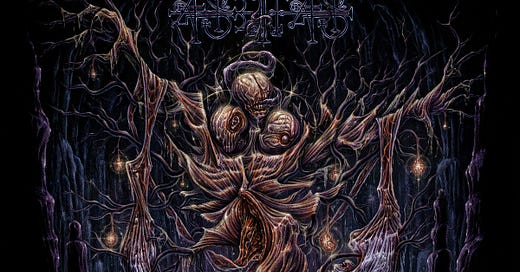Interview: Aseitas
The Portland band's stellar new album 'Eden Trough' and its centerpiece, "Tiamat"
This mini profile originally ran in Stereogum’s The Black Market in June 2024.
It may be cliché, but you can find out a lot about a band through the name it chooses. “The concept of ‘Aseitas’ characterizes self-caused existence,” Aseitas writes in an email. “Since our start, the principles of independence have been central in our process. All of our songs start with themes, which birth endless variations that we combine, integrate, and twist beyond recognition. This leaves the song with a consistent musical DNA, no matter where we take it.”
The Portland quartet takes it quite a few places on Eden Trough, its third full-length. Though clocking in at a svelt sub-30-minute runtime, the five-song album feels much grander and wide-ranging due to its adventurous experimentalism that leaves few stylistic stones unturned. Put more simply, it has earned the RIYL going around of “Car Bomb meets Ehnahre.”
“Some fans have described us as ‘evil jazz,’ Aseitas adds. “Our nods to Charles Mingus and Eric Dolphy became most prominent on Eden Trough, going so far as to reference the head of ‘Meditations on Integration.'” Other influences run the gamut, from “King Crimson, Igor Stravinsky, Guided By Voices, Gorguts, Gojira, Intronaut, Demilich, Celtic Frost, Nails, and countless more.” Even Ludwig Goranssön’s Tenet score inspired a snippet of “Alabaster Bones,” one of two epics on Elden Trough‘s second half.
Speaking of, “Alabaster Bones” has another interesting influence. On an album with fascinatingly short lyrical lines, these clipped impressions that read like how a camera’s flash looks, “Alabaster Bones”‘s lyrics stretch out, reflecting the punishing post-apocalyptic vastness of its inspiration. “Before any lyrics were penned for ‘Alabaster Bones,’ there was a clear vision to its instrumental writing, thematically based on The Road by Cormac McCarthy,” Aseitas explains. “Structurally, each section of the song was associated with a specific element of the story. Adapting a 300-page book into a seven-minute song is a major effort in distillation, so more lyrics were necessary to convey the story.”
And that’s what Aseitas continually excels at throughout Eden Trough: distilling reams of information down to wonderfully evocative songs that revel in the joys of the journey. The band blazes new trails while setting aside time to construct memorable motifs that stick in your mind. As an example, the two-and-a-half-minute instrumental “Null Adam/Null Eve” excels at both approaches, proving that Aseitas doesn’t have to go long to make an impact.
“Continuing on the concept of motifs, ‘Null Adam/Null Eve’ encapsulates sections from a few songs; ‘Null Adam’ interprets the ‘Libertine Captor’ motif, and ‘Null Eve’ exploits chords from ‘Break the Neck of Every Beautiful Thing,'” Aseitas notes. “Null Adam/Null Eve,” then, becomes this beautiful little jewel in the center of the storm. It’s a breather, but it’s clever sequencing, snapping an aural picture of Eden Trough‘s front half by subtly highlighting, reinstilling, and reinventing some of its finest moments. It’s the Aseitas MO in action, to “combine, integrate, and twist beyond recognition.” And because “Null Adam/Null Eve” additionally foreshadows a future section in the album’s following song, it’s also a fine segue to Eden Trough’s headiest work, “Tiamat.”
As Aseitas says, “Writing was a balance of indulgence and keeping things lean,” and that’s no clearer than on “Tiamat.” The 10-minute penultimate brain-melter is the epitome of what makes Eden Trough unique. “‘Tiamat’ was conceived with a mind to explore counterpoint guitarwork,” and, jeez, do the guitars get a workout here. The opening riff is that prog death good stuff. Guitarists Gage Dean, who also plays bass, and Travis Forencich keep that riff moving, continually iterating on its badassery while it dips and dives through numerous permutations. Drummer Zack Rodrigues stuns with an avalanche of rhythms that always land in the right spots. And vocalist Nathan Nielson is able to dexterously dart in and out of the pocket while maintaining a varied and engaging delivery. Then, at 4:40, “Tiamat” takes a turn toward one of the best stretches of metal this year. After a brief reset with quieter guitars, Aseitas launches into a glorious section that’s like if Opeth commandeered Nothing-era Meshuggah. It is absolute bliss if you’re a particular type of metal fan. And the fact that this song fosters flow states that make it feel like a tenth of its actual length is a sonic miracle for a work this dense and complex.
Naturally, that brings up two big questions about Aseitas’s compositional prowess. When working with songs that are this detailed and multifaceted, how does the band map all of these components out? How do they make it flow so well? “The writing of Eden Trough started in 2019, so these songs were cooking for a good four years before we tracked them,” Aseitas explains. “Since we’re always pushing our own bounds of complexity, there’s constant shifts in how we write. There’s value in having one person focusing on a song, as well as writing as a group. Individually, we’ll record demos that initially involve many broad strokes. The band then learns from these demos before coming together to refine them. Working as a group brings an organic quality; following our intuitions is key to making the material flow.”
Prone to refine while following its intuition. That is Aseitas’s consistent musical DNA. And on Eden Trough, it takes the band far.




